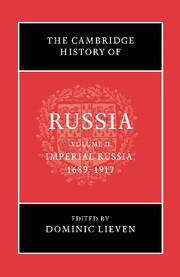Book contents
- Frontmatter
- Introduction
- Part I Empire
- Part II Culture, Ideas, Identities
- Part III Non-Russian Nationalities
- Part IV Russian Society, Law and Economy
- Part V Government
- Part VI Foreign Policy and the Armed Forces
- 23 Peter the Great and the Northern War
- 24 Russian foreign policy, 1725–1815
- 25 The imperial army
- 26 Russian foreign policy: 1815–1917
- 27 The navy in 1900: imperialism, technology and class war
- Part VII Reform, War and Revolution
- Bibliography
- Index
- Map 5. The Russian Empire (1913). From Archie Brown, Michael Kaser, and G. S. Smith (eds.) Cambridge Encyclopedia of Russia 1982.">
- Plate Section">
- References
26 - Russian foreign policy: 1815–1917
from Part VI - Foreign Policy and the Armed Forces
Published online by Cambridge University Press: 28 March 2008
- Frontmatter
- Introduction
- Part I Empire
- Part II Culture, Ideas, Identities
- Part III Non-Russian Nationalities
- Part IV Russian Society, Law and Economy
- Part V Government
- Part VI Foreign Policy and the Armed Forces
- 23 Peter the Great and the Northern War
- 24 Russian foreign policy, 1725–1815
- 25 The imperial army
- 26 Russian foreign policy: 1815–1917
- 27 The navy in 1900: imperialism, technology and class war
- Part VII Reform, War and Revolution
- Bibliography
- Index
- Map 5. The Russian Empire (1913). From Archie Brown, Michael Kaser, and G. S. Smith (eds.) Cambridge Encyclopedia of Russia 1982.">
- Plate Section">
- References
Summary
During the final century of Romanov rule, Russian foreign policy was motivated above all by the need to preserve the empire’s hard-won status as a European Great Power. The campaigns and diplomacy of Peter I, Catherine II and the other emperors and empresses of the eighteenth century had raised their realm’s prestige to the first rank among the states that mattered in the West. The stunning victories in the French revolutionary wars at the turn of the nineteenth century marked the apogee of tsarist global might. By defeating Napoleon’s designs for continental dominion in 1812, Tsar Alexander I won an admiration and respect for Russia unparalleled in any other age. The difficult challenge for his heirs would be to keep Alexander’s legacy intact.
Despite a reputation for aggression and adventurism, nineteenth-century tsarist diplomacy was essentially conservative. In the West, Russian territorial appetites were sated. Having recently absorbed most of Poland, one traditional foe, and won Finland from its erstwhile Swedish rival, the empire kept its European borders unchanged until the dynasty’s demise in 1917. The imperative here was to protect these frontiers, especially the Polish salient. Surrounded on three sides by the Central European powers of Austria and Prussia, Poland never reconciled itself to Russian rule, and the restive nation seemed particularly vulnerable to foreign military aggression and revolutionary agitation. Maintaining the continental status quo therefore appeared to be the best guarantee for securing Russia’s western border. For much of the nineteenth century, the Romanovs would strive to maintain stability in close partnership with Europe’s other leading conservative autocracies, the Prussian Hohenzollerns and the Austrian Habsburgs.
Keywords
- Type
- Chapter
- Information
- The Cambridge History of Russia , pp. 554 - 574Publisher: Cambridge University PressPrint publication year: 2006
References
- 3
- Cited by

